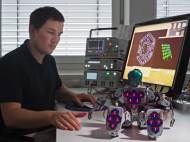A different approach on sensitive skin for robots development
 Researchers at Technical University of Munich (TUM) are developing an artificial skin for robots to help them navigate in their environments. It will provide important tactile information to the robot and thus supplement its perception formed by camera eyes, infrared scanners and gripping hands. They have built a single robotic arm equipped with sensors to prove the concept works.
Researchers at Technical University of Munich (TUM) are developing an artificial skin for robots to help them navigate in their environments. It will provide important tactile information to the robot and thus supplement its perception formed by camera eyes, infrared scanners and gripping hands. They have built a single robotic arm equipped with sensors to prove the concept works.
“In contrast to the tactile information provided by the skin, the sense of sight is limited because objects can be hidden”, said Philip Mittendorfer, a researcher who develops the artificial skin at the Institute of Cognitive Systems at TUM.
The centerpiece of the new robotic shell is a 5 square centimeter (0.77 square inch) hexagonal plate. Each small circuit board contains four infrared sensors that detect anything closer than 1 centimeter (0.4 inches). There are also six temperature sensors and an accelerometer. This allows the machine to accurately register the movement of individual limbs, for example, of its arms, and thus to learn what body parts it has just moved.
“We try to pack many different sensory modalities into the smallest of spaces”, said Mittendorfer. “In addition, it is easy to expand the circuit boards to later include other sensors, for example, pressure.”
The sensor boards are placed together forming a flat honeycomb-like structure to be worn by the robot. In order to enable the detection ability, the signals from sensors are processed by a central computer. This enables each sensory module to pass its own information, and serve as a data hub for different sensory elements as well. This happens automatically, ensuring that signals can go in alternative ways if a connection should fail.
To prove their concept, the researchers used 15 sensors and placed them on each segment of a long robot arm. Just a light pat or blow ensures that the arm reacts. The pioneering aspects of the concept do not end with its sensory accomplishments. The machines equipped with their sensor skin could someday be able to incorporate biological fundamental neurobiological capabilities and form a self-impression.
“We will close the skin and generate a prototype which is completely enclosed with these sensors and can interact anew with its environment”, said Mittendorfer’s supervisor, Prof. Gordon Cheng.
As with human skin, the way the artificial skin is touched could, for example, lead to a spontaneous retreat (when the robot hits an object) or cause the machine to use its eyes for the first time to search for the source of contact. Such behavior is especially important for robotic helpers of people traveling in constantly changing environments.
We already wrote about another way to achieve skin mimicking which is achieved by rubberized piezoelectric type fabric used to transmit electrical signals when touch is detected, and we believe it is currently more precise and cost efficient. However, further development of technology described in this article could be used alongside stretchable skin in order to provide more data at areas of interest.









I’ve been here a few times and it seems like your articles get much more informative every time. Keep it up, I enjoy reading them.